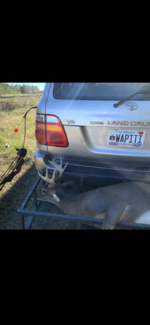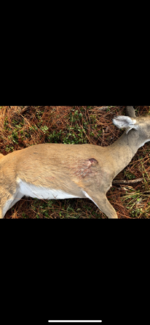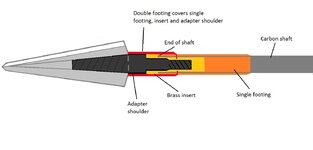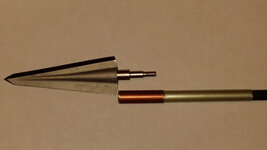Sapcut
WKR
Gold Tip Ultralight 300, TuffHead 300, 200 grain Tuff adapter, aluminum insert, 7” single footing, 1.5” double footing over single footing and over flat shoulder of adapter snug behind broadhead.Can I ask you what your current “indestructible hunting arrow” is? Arrow, broadhead, etc. Any footers?
I designed the Tuff adapter for TuffHead a few years ago from a prototype I made and used before that. The bottom of tapered portion has a flat shoulder area (1/8-3/8” long depending on weight) then the threaded shaft. Perfect for sliding the double footing over. This bridges the weakest point of shaft where the insert joins the threaded shaft.
The long footing certainly strengthens killing end of shaft but it also stiffens the shaft to handle the weight up front and tune for perfect flight. I would never build and shoot a shaft without a long footing system of some kind. It makes an hunting arrow crazy efficient, easier to tune and boneproof.
Last year I killed the pig and several deer with same arrow including a buck at 27 yards off the ground. Quartering to shot entered the shoulder blade and exited rib cage. Also killed a big doe at about 20 yards with arrow entering flank and exiting shoulder stuck in ground. Turning a gut shot into recovered nutrition.
Attachments
-
 051F089B-6DA6-4D94-B27B-603CDB68805D.png682.1 KB · Views: 29
051F089B-6DA6-4D94-B27B-603CDB68805D.png682.1 KB · Views: 29 -
 CC02DD59-74AA-4261-B162-EAEAE9BF4DC8.png1.7 MB · Views: 31
CC02DD59-74AA-4261-B162-EAEAE9BF4DC8.png1.7 MB · Views: 31 -
 A216C1F3-B64A-43C1-9298-ABD96B42173D.png1.5 MB · Views: 32
A216C1F3-B64A-43C1-9298-ABD96B42173D.png1.5 MB · Views: 32 -
 0F03DDC7-DB9F-41B1-8C62-3A19844EEA75.png859.8 KB · Views: 31
0F03DDC7-DB9F-41B1-8C62-3A19844EEA75.png859.8 KB · Views: 31 -
 7D354AAA-850C-491A-A9C3-9E03EAA889B5.png798.9 KB · Views: 27
7D354AAA-850C-491A-A9C3-9E03EAA889B5.png798.9 KB · Views: 27



